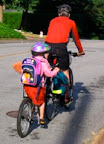In Support of the Mudflap
In my last entry I talked about the essential tools for commuting in the rain. I mentioned the mudflap, not this kind of mudflap, as an essential part of the fender. This is a follow up to that post.
I recently bought a new pair of fenders for my commuter. My old fenders were a little narrow and I wanted wider tires, so I decided to get bigger fenders. The new fenders are Planet Bike Freddy Hybrids. Now these fenders have a "mudflap" attached so I didn't add my own initially. After a few rides I realised that the mudflaps were less function and more fashion though.
In general mudflaps channel water away from the rider and back onto the road. In most cases front fenders are too short and water that is supposed to be channeled to the road ends up on your feet and in your drive train. It is the latter that tipped me off that my mudflaps on the Freddy's was woefully inadequate.
After a week of riding to work and having a) soaking wet feet (even with shoe covers on, and b) a grinding sensation in my drive train I decided it was time to replace the Freddy's flaps with some "Monster" flaps.
 As you can see from this picture the "water line" is above my front chain ring. This caused all the lube on my chain to be washed away leaving a terrible metal-on-metal-with-some-sand-mixed-in-grinding-sound.
As you can see from this picture the "water line" is above my front chain ring. This caused all the lube on my chain to be washed away leaving a terrible metal-on-metal-with-some-sand-mixed-in-grinding-sound.
The flap needed to be close to the ground and needed to channel the water better.
I used a drill to remove the rivets holding the flap on and then drew and cut a proper flap. My old muflap on my previous fenders was a "plain Jane" model. It was straight on both sides, it went almost to the ground, it was oh so practical, but a bit boring. So this time I thought I'd make it a little more graceful.

What you need to make this happen.
1) a drill ( to make a 2 holes in your fender to attach the new flap
2) zap strap
3) Stair tread rubber (Home Despot)
4) Scissors (careful with these they seem to be dangerous to some)
5) Template (print the image below)
Print the template , tape it to your stair tread rubber and cut it out (carefully). Drill two holes in your fenders 2 and 3 cm from the base of the fender (one on above the other). Align and cut two holes in your mudflap. Attach the mudflap to the fender with the zap strap. Voila a stylish and effective tool for keeping the sand and water out of your drive train and off your feet.


I recently bought a new pair of fenders for my commuter. My old fenders were a little narrow and I wanted wider tires, so I decided to get bigger fenders. The new fenders are Planet Bike Freddy Hybrids. Now these fenders have a "mudflap" attached so I didn't add my own initially. After a few rides I realised that the mudflaps were less function and more fashion though.
In general mudflaps channel water away from the rider and back onto the road. In most cases front fenders are too short and water that is supposed to be channeled to the road ends up on your feet and in your drive train. It is the latter that tipped me off that my mudflaps on the Freddy's was woefully inadequate.
After a week of riding to work and having a) soaking wet feet (even with shoe covers on, and b) a grinding sensation in my drive train I decided it was time to replace the Freddy's flaps with some "Monster" flaps.
 As you can see from this picture the "water line" is above my front chain ring. This caused all the lube on my chain to be washed away leaving a terrible metal-on-metal-with-some-sand-mixed-in-grinding-sound.
As you can see from this picture the "water line" is above my front chain ring. This caused all the lube on my chain to be washed away leaving a terrible metal-on-metal-with-some-sand-mixed-in-grinding-sound.The flap needed to be close to the ground and needed to channel the water better.
I used a drill to remove the rivets holding the flap on and then drew and cut a proper flap. My old muflap on my previous fenders was a "plain Jane" model. It was straight on both sides, it went almost to the ground, it was oh so practical, but a bit boring. So this time I thought I'd make it a little more graceful.

What you need to make this happen.
1) a drill ( to make a 2 holes in your fender to attach the new flap
2) zap strap
3) Stair tread rubber (Home Despot)
4) Scissors (careful with these they seem to be dangerous to some)
5) Template (print the image below)
Print the template , tape it to your stair tread rubber and cut it out (carefully). Drill two holes in your fenders 2 and 3 cm from the base of the fender (one on above the other). Align and cut two holes in your mudflap. Attach the mudflap to the fender with the zap strap. Voila a stylish and effective tool for keeping the sand and water out of your drive train and off your feet.


Labels: bikes, biking, commuting, Tips, transportation


